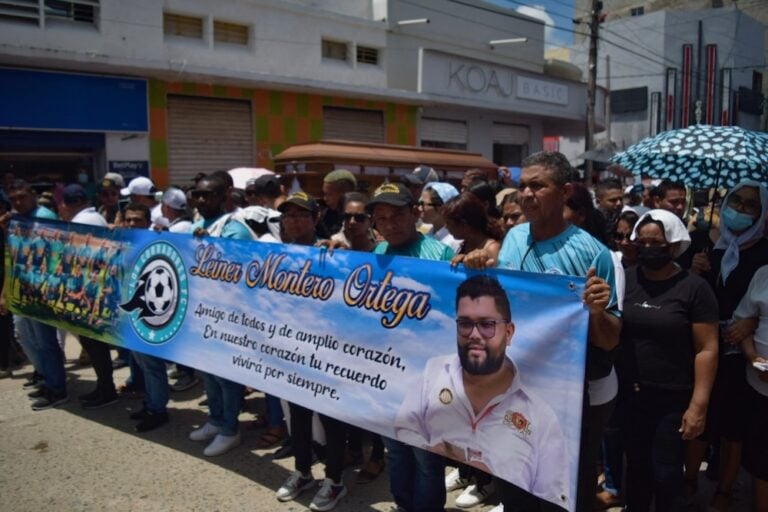(CESO-IFJ/IFEX) – Photojournalist Rafael Bruno Bruno was found dead, shot in the head, at his home in the Bellavista neighbourhood of the city of Cúcuta, capital of the Norte de Santander department, in confusing circumstances on the evening of 19 December 2007. The body of the “La Opinión” daily’s photojournalist was discovered on the patio […]
(CESO-IFJ/IFEX) – Photojournalist Rafael Bruno Bruno was found dead, shot in the head, at his home in the Bellavista neighbourhood of the city of Cúcuta, capital of the Norte de Santander department, in confusing circumstances on the evening of 19 December 2007.
The body of the “La Opinión” daily’s photojournalist was discovered on the patio of his house, where according to neighbours, several gunshots were heard, apparently during a confrontation.
Bruno arrived home at 9:10 p.m. (local time) in his vehicle. Before going inside his residence, he spoke to children who frequently visited his home to get candy. Neighbours found it odd when he did not go outside to listen to music on a small radio, as he did every night. Instead, five minutes after he arrived and closed his door, neighbours heard small explosions, similar to those produced by fireworks, and the journalist’s dogs barking, which aroused concern among those who knew him.
After knocking on his door and calling his cell phone several times, neighbours contacted the police. Police officers entered Bruno’s house, found his lifeless body face down and a gun in his right hand. It was later reported the gun cylinder had only one cartridge left.
The day had been a normal one for the journalist. He took photographs of a bridge for a special report that will be published in the newspaper’s 23 December issue and in the afternoon, before heading home, he shared a holiday dinner with colleagues from “La Opinión” and discussed his plans for the next few days.
Bruno was born 76 years ago in Salazar de Las Palmas. He was a passionate photographer always hunting for news. His lens had captured important moments in the region, such as the demobilisation of the Catatumbo Block of the United Self-Defense Forces of Colombia in Tibú, near the end of 2004. Every November he went to Cartagena to cover the National Beauty Pageant, where he always accompanied the candidate of Norte de Santander.
Bruno was a committed activist in the city of Cúcuta. He was the head of several social organisations: the National Federation of Merchants (FENALCO), the Colombian Association of Small Industries (ACOPI) and the National College of Journalists (CNP).
“The Colombian Federation of Journalists and the Solidarity Centre of the International Federation of Journalists express our condolences to Rafael’s family and colleagues of ‘La Opinión'”, said Eduardo Márquez, president and director of the organisations. “We also call upon authorities to conduct a serious investigation that does not dismiss the possibility of a murder, as the hypothesis of a suicide is not very believable, if we consider his final hours.”
Bruno’s death occurred in an environment of significant police hostility toward journalists from “La Opinión”. On 18 December, while covering an eviction of individuals from a home, in compliance with a judicial decision requested by a bank, members of the antiriot squad of the police, ESMAD, physically and verbally attacked journalism intern Marta Forero, photographer Carlos Patiño, William Pantano of APN television station and other journalists present at the scene.
Six days earlier, on 12 December, two other journalists from “La Opinión” – photojournalist Gabriela Sierra and editor Hugo Gonzalez – were pushed by traffic police when covering the murder of a police station chief. An agent identified by the last name of Alvárez, pushed away journalists, while other officers tried to confiscate Sierra’s camera. González showed his vest identifying him as media worker from “La Opinión”, but the officer pulled him by the pockets, demanded he show his identification card and then sent him to the prosecutor.
“La Opinión” sub-director Cicerón Florez alerted CESO-IFJ about his concern over the current increasing limitations on journalistic coverage of judicial events. Florez noted that journalists recognise that there legal limitations, in order to safeguard criminal investigations, but says “the attitude of state forces in Cúcuta is disproportional to the agreed-upon limits.” “As time goes by, repressive positions, insults and attacks by the National Police, ignored by high-ranking officers, have become ever more common,” he concluded.
Marquez says that these new cases of acts of aggression by the police will be presented before the Attorney General’s Office (Procuraduría General de la Nación) on behalf of the IFJ and that those responsible must be sanctioned.
FECOLPER represents more than 1000 journalists in 18 departments of Colombia. The IFJ represents more than 600.000 journalists in 120 countries.


